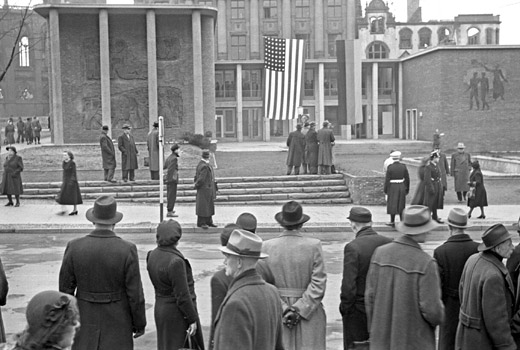
Alliierte im Ruhrgbiet
Recht schnell sahen die Besatzungsmächte nach dem Zweiten Weltkrieg von einer Stilllegung des Ruhrbergbaus ab und sahen in der Kohleförderung eine notwendige Grundlage für den Wiederaufbau. Sie übernahmen aber die Kontrolle über den Ruhrbergbau. Die neu gegründeten Amerikahäuser sollten nach der Zeit des Nationalsozialismus demokratische Kultur und Werte vermitteln und waren ein Element der amerikanischen Politik der »re-education«.
© Stadtbildstelle Essen, Foto Hagen
Herrschaft zurück zur Auswahl
The Reorganisation of mining and democratization through western culture
From the point of view of the Allied Forces Essen as the “Armoury of the Reich“ and the administrative centre of the Ruhr mining industry was the most significant town in the Ruhr Region after the Second World War. Many allied institutions were based here, among them the North German Coal Control (NGCC), which, in the summer of 1945, took over control of coal mining in the Ruhr Region. The long-term goal was the decentralization of the coal mining industry, as the industry in general, and to establish long-term control over the considerable coal supplies in the district. Already in 1947, the British and the Americans softened their strategy; they began to place greater emphasis on cooperation with German institutions and management and set up autonomous institutions, such as the Deutsche Kohlenbergbau-Leitung (DKBL) with an office in the Villa Hügel. This was intended – under direct control of the Allied Forces - to restart coal mining which had been disrupted by the war. At the end of 1947 it relocated to the Glückaufhaus, which served, shortly after the end of the war, as the office of the British town major. In 1953 the DKBL was dissolved.
Besides political and economical control, the American occupation policy also placed great emphasis on a changed attitude of the people. This lay behind the establishment of "Amerikahäuser" in many German cities and towns. On the basis of a law passed in 1948, such „U.S. Information Centers“ were established internationally in over 70 countries, and they were intended to help "promote a better understanding of the United States […] and deepen the mutual understanding between the American people and the peoples of other nations...“
With the beginning of the cold war, there was a shift in the initial purpose of the Amerikahäuser. The "educational" goal now lay less in “re-educating the Germans and the elimination of national socialistic ideas, but in a defence propaganda against communism. By 1951, the Federal Republic had 135 smaller reading rooms and 27 Amerikahäuser, which, in the cultural climate of the post-war period, quickly gained popularity due to a lack of alternative opportunities. Offering free libraries, lecture events, concerts, exhibitions, readings, and film screenings, they provided a welcome change. Whether these Amerikahäuser actually had the intended effect despite the great number of visitors is questionable, because on 18th June 1951, the American High Commission for Germany announced the closure of 12 houses and 100 reading rooms. Attention now focused on places in population centres such the Ruhr Region, where up to now no such facilities had been opened.
The establishment of the Amerikahaus Ruhr, opened in 1952, marks on the one hand a turning point in the development of the institution, but in terms of the materials used and the symbolic value of the newly constructed building it was also a high point. The Amerikahaus Ruhr was the first building in Germany designed and built for this purpose, and stood out form among the buildings commonly used by the Allied Forces.
Denkmale zum Impuls
Essen - Glückaufhaus in Rüttenscheid
weiter
Essen - Kennedyhaus
„Ich lernte, dass die amerikanische Kultur genauso hoch entwickelt ist wie unsere, auch ... weiter

